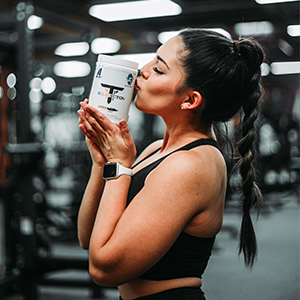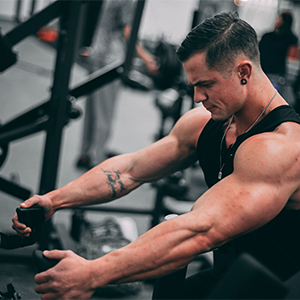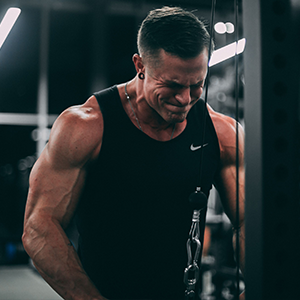
The Minimum Effective Dose For Hypertrophy
Many people say they're too busy for muscle-building, but guess what? Even a short workout can make a difference. The trick is finding the sweet spot in your training routine.
Studies indicate that doing more sets (like multiple sets) is more effective for muscle growth than doing fewer sets (just one, for example). So, how many sets do you actually need?
A recent study looked at different training volumes: low (less than 5 sets per week), moderate (5-9 sets per week), and high (10+ sets per week).
They found that doing at least 10 sets per week doubled the muscle growth compared to doing less than five. Even the super simple approach of doing less than 5 sets still gave reasonable gains at 5.4%.
This is perfect for those struggling to find time between work, travel, and family for the gym. You can still progress by shortening your sessions or working out less often, which makes your training more focused and intense.
Keep Yourself Healthy with Just Enough Exercise
You might believe working out a ton is the only way to stay in shape, but that's not the case. You don't have to exercise every day like an Olympic athlete.
For most folks, doing three weekly workouts, lasting 30 to 60 minutes each, is sufficient to stay healthy. And hey, even a daily brisk walk can make a difference if you're not super active.
Think of it as finding the perfect amount for your fitness goals, your Minimum Effective Dose (MED). If you want to live longer, aim for 150 minutes of moderate exercise every week. That could be as simple as three short 10-minute walks each day.
To build strength, three one-hour sessions each week where you really put in effort – not just counting reps – can get you great results. If you're focusing on your heart health, try high-intensity interval training (HIIT) twice weekly.
And don't forget about flexibility! Try dynamic stretching like high knees or arm circles if you want to limber up before a workout. When you're doing exercises, work your muscles through their full range of motion – it helps boost flexibility.
Remember, it's about finding the right balance for your goals, not doing too much or too little.

What is the Minimum Effective Dose for Hypertrophy?
When you lift things, remember four simple rules:
- Frequency
- Volume
- Loads
- Repetition
- Rest
Training Frequency And Volume:
How often you work out and how much you do are important in training. New findings suggest that you can get similar results working out once a week compared to more often, as long as the total weekly workout amount is the same.
If you match the total workout volume, whether it's the number of times you lift or how much weight you lift, the impact on getting stronger or building muscles is the same, regardless of how often you work out.
Working a muscle once a week gives similar strength gains as working it at least three times a week, as long as the total workout amount is equal.
For those who don't want to exercise, doing short sessions more frequently, like 15 minutes at a time, works just as well. This is because these short workouts have similar benefits to traditional longer ones, mainly because of the total weekly workout volume.
Looking at the least you need to do, some studies show that doing just one set three times a week is enough to get stronger and build muscle. This is especially good for beginners and older folks.
Even for those who already work out, doing just one set of 6–12 repetitions two to three times a week with a moderate amount of weight is the least you need to increase strength.
While doing more workouts is generally better for building muscles, you can still get stronger and build muscle with fewer weekly sets (less than 5 sets). However, it's a bit unclear what "less than 5 sets" really means, so it's suggested to aim for at least 4 sets per muscle.
If you're thinking of doing more, consider how much time you want to spend versus how much more muscle you might gain.
Training Load And Repetitions
How much weight you use (training load) is important in strength training. Experts recommend a range of repetitions, like 6 to 12 reps, to strengthen and build muscles. Using heavier weights is a good idea if you're short on time.
Recent studies show that you can still grow muscles using light weights if you put in a lot of effort and do enough sets. But, for those already used to lifting weights, using heavier ones is better for getting stronger.
If you don't have much time or have joint problems, using lighter weights can be a good option, especially if you're working out at home. So, even if it's heavy or light, the key is to put in the effort to make your muscles work.
Rest
The best rest time between exercises can vary based on how long you've been training, the type of muscles you have, and your genes. Studies say that if you want your muscles to grow, taking short breaks of 30-60 seconds between sets with moderate effort is good.
Also, if you want to get stronger quickly, a rest of about 1 minute between exercises works well.
Exercise Selection
Create an efficient workout routine by selecting one exercise from each category - push, pull, and legs - daily. Begin with a warm-up, followed by 2 sets of 6 reps for each chosen exercise.
Maintain an intensity level of 70-85% of your one-repetition maximum (1RM), pushing yourself during the final set while ensuring proper form. Allow a 1-minute rest between sets to optimize performance.
Lift twice a week, ensuring at least a 2-day gap between sessions. The entire workout, inclusive of breaks and a 3-minute warm-up, wraps up in just 20 minutes.
Exercise Options:
Pull:
- Pullup
- Bent Over Row
- High Pull
Push:
- Chest Press
- Overhead Press
- Incline Chest Press
Legs:
- Deadlift
- Squat
- Lunge
Efficiency Tips:
Here are some efficiency tips to get better at it:
- Choose exercises that work many muscles at once for faster sessions.
- Using a barbell is quicker and lets you lift heavier than with dumbbells.
- Bilateral exercises (both sides together) are time-efficient unless you want to focus on core activation.
- Unilateral exercises (one side at a time) work well, especially for harder workouts at home with less weight.

Advanced Time-Saving Training Methods
You can save time by following these 3 best time-saving methods:
Superset Training:
- Perform 2 or more exercises in succession with limited rest.
- Limited scientific evidence supports its efficiency, but studies suggest it can save time without compromising training volume.
- It is particularly beneficial when pairing exercises for agonist and antagonist muscles.
Drop Set Training:
- Reduce training time by minimizing rest between sets.
- Involves performing a traditional set, reducing the load, and immediately performing another set (or multiple sets).
- Typically uses 1–3 drops with a 20–25% reduction in weight, all sets performed to muscular failure.
- Despite limited evidence, drop-set training allows for shorter workouts without significant reductions in training volume, making it suitable for time-pressed individuals.
- Most studies focused on single-joint, upper-body exercises; caution is advised for compound, free-weight exercises like squats due to safety concerns.
Rest-Pause Training:
- Structured sets with preplanned rest within the training sets.
- Sets are segmented into smaller sets with short breaks.
- Two approaches: 4–6 sets of single repetitions using a load close to 1RM or one set to failure with short breaks until the preplanned number of repetitions is achieved.
- Evidence is equivocal, but rest-pause training appears efficient for improving strength and muscle size when time is a constraint.
- Intense training method, suitable for those with some training experience, especially when performing complex multi-joint, free-weight exercises.
Building Muscle with Protein - Simple Tips
When we want to build muscles, it's important to have more protein coming in than going out. After we exercise, our muscles work best to grow. Our muscles get bigger over time if we do activities like lifting weights or bodyweight exercises and eat well.
As we age, we should eat more protein, especially around 50 years old, about one gram for every kilogram we weigh, to keep our muscles strong.
If we regularly exercise, we need more protein than what's usually suggested. If you are lifting weights or training for events like running or cycling, you should aim for 1 gram of protein per pound of lean body mass.
If meeting these protein requirements through whole foods becomes challenging, individuals may consider supplementing with high-quality protein sources to support their fitness goals.
Takeaway:
Doing at least 10 sets per muscle group each week with reps between 6-12 is ideal to see muscle growth. If tight, focus on efficient compound exercises like squats and deadlifts that work for multiple muscle groups. Consistency over time is key for midlife gains.
For those with busy schedules, choosing a more efficient training program is better than sacrificing sleep. Remember, maintaining just one-third of your usual training volume per muscle group can keep your muscles in good shape. It's a smart choice when time is limited—maintaining is better than losing.




Leave a comment